Livestock highlights

Artificial Insemination of Cattle Boosts Milk and Meat Production in Bangladesh
The support from the Joint FAO/IAEA Centre greatly increased the production of milk and meat at the country level, making contribution to the achievement of SDGs, in particular SDGs 1, 2, and 3.
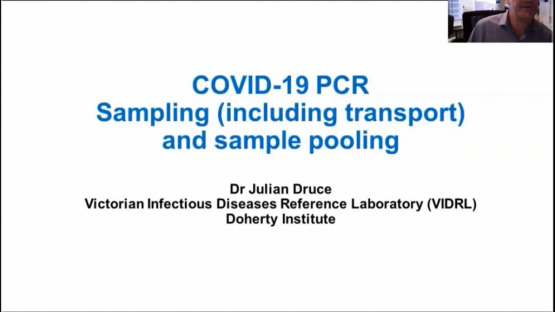
IAEA and WHO-WPRO Webinar Series Number 2: Support to Member States on the Use of RT-PCR for COVID-19
IAEA and WHO-WPRO Webinar Series Number 2: Support to Member States on the Use of RT-PCR for COVID-19.
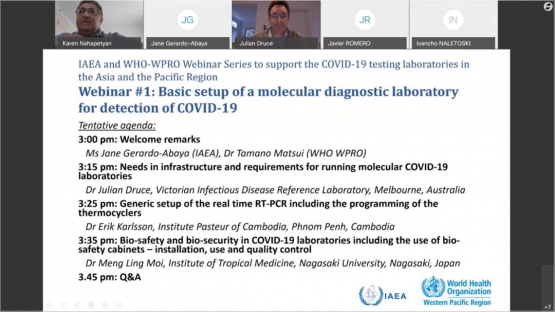
IAEA and WHO-WPRO Webinar Series Number 1: Support to Member States on the Use of RT-PCR for COVID-19
IAEA and WHO-WPRO Webinar Series Number 1: Support to Member States on the Use of RT-PCR for COVID-19.

COVID-19 Webinar on RT-PCR; from Understanding the Zoonotic Origin of the Virus, to Transmission and Diagnosis in Humans
COVID-19 Webinar on RT-PCR; from Understanding the Zoonotic Origin of the Virus, to Transmission and Diagnosis in Humans.

Establishing Genetic Characterization and Breeding Capability for Livestock in Burkina Faso
Burkina Faso is a West African country with 17.3 million people, where the majority of people live in rural areas and rely on agriculture, mainly livestock rearing.
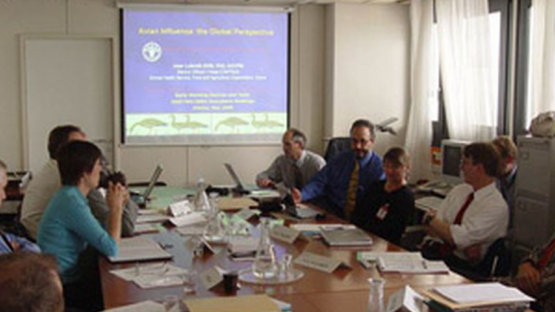
The Joint FAO-IAEA Division is Supporting Member States to Combat H7N9 Avian Influenza - a New Avian Influenza Virus Concern for Humans
Avian Influenza, also known as “Avian Flu” or “Bird Flu” is caused by a virus that has a reservoir in wild birds.

FAO-AG Confers an Outstanding Teamwork Award to the Animal Genetic Resources Team
An Outstanding Teamwork Achievement Award was conferred on January 26 to the Animal Genetic Resources Team by the Agriculture and Consumer Protection Department of the Food and Agriculture Organization of the United Nations (FAO) for its activities and superior accomplishments in supporting the Global Plan of Action for Animal Generic Resources (AnGR) and enhancing Member State capacities on characterization, conservation and sustainable improvement of locally-adapted livestock in Africa, Asia and Latin America.
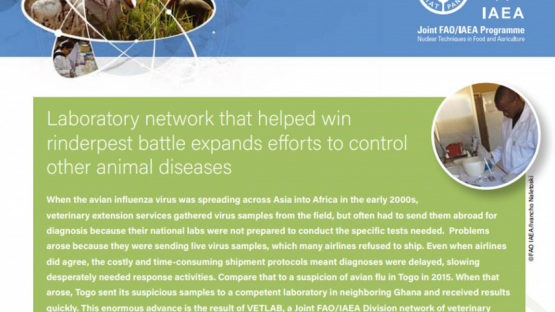
Laboratory Network that Helped Win Rinderpest Battle Expands Efforts to Control Other Animal Diseases
When avian influenza spread across Asia into Africa in the early 2000s, veterinary extension services were largely unprepared and unable to conduct the specific tests needed - a network to collaborate and share technical expertise was urgently needed.
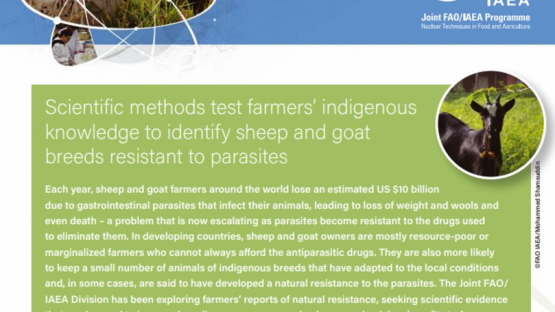
Scientific Methods Test Farmers’ Indigenous Knowledge to Identify Sheep and Goat Breeds Resistant to Parasites
In a scientific study, farmers in ten developing countries were asked to identify one sheep or goat breed that they considered to be naturally resistant and one naturally susceptible to parasitic infection.
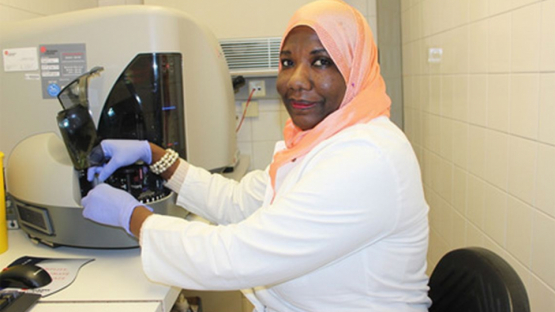
IAEA Assists Sudan in the Control of Animal Diseases through the Development of Vaccines
Control and eradication of animal diseases are crucial for food security and improving the livelihoods of farmers.
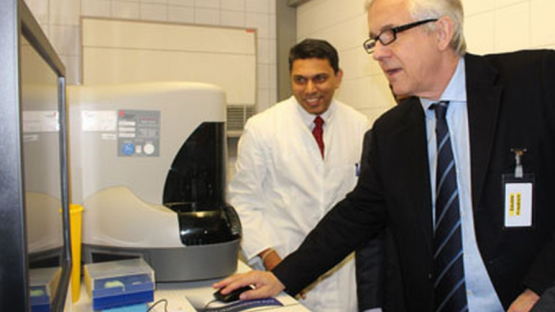
Improving Vaccine Efficiency to Fight Livestock Diseases with New Flow-Cytometer
Vaccines protect livestock against animal diseases and are crucial in disease control programs. Before novel vaccines are released to the market, they undergo a long and complex development, testing and approval process.
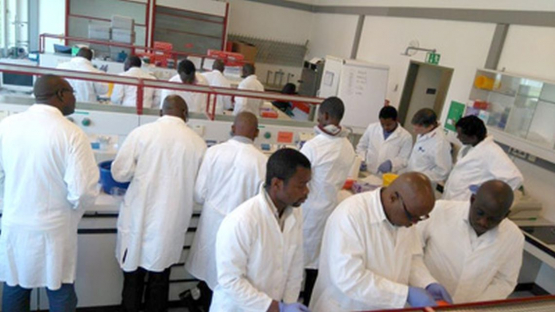
IAEA Training Course Helps Tackle the H5N1 Avian Influenza Outbreak in West Africa
Nigeria in January, Burkina Faso and Niger in April, Côte d’Ivoire at the end of May, Ghana a few days later in the beginning of June – a list that reads like a travel itinerary through West Africa traces the route of recent bird flu outbreaks in the region.

IAEA Supports Belize to Strengthen their Animal Health Diagnoses and Control Capacities
Agriculture in Belize plays a significant role in the country’s economic stability and growth in terms of foreign exchange earnings, income generation, employment, nutrition, and food security.

Building Veterinary Laboratory Capacity in Africa: THE VETLAB NETWORK
Transboundary animal diseases and those that affect human health have a strong impact on community livelihoods, trade and public health. Early and rapid diagnosis and control of these diseases require concerted interdisciplinary actions at national and international levels.
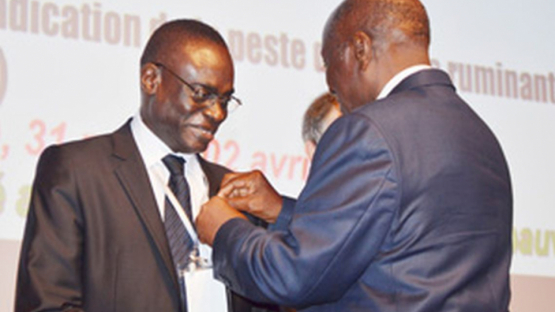
A Tribute to the Work of the Joint FAO/IAEA Centre for the Control and Eradication of Peste des Petits Ruminants (PPR)
At the International Conference for the Control and Eradication of Peste des Petits Ruminants (PPR) held in Abidjan, Côte d’Ivoire, in April, Dr Adama Diallo, a staff member of the Joint FAO/IAEA Division, was elevated to the grade of Officer of the National Order of the Republic of Cote d’Ivoire.

Ethiopia Awards IAEA for Continuous Support in Veterinary Disease Diagnostics
Since 2011, the IAEA, through the Joint FAO/IAEA Centre, has increased its support to a network of veterinary laboratories (“VETLAB Network”) in sub-Saharan Africa through a project entitled “Strengthening Veterinary Diagnostic Laboratories in Africa for Rapid and Specific Diagnosis of Transboundary Animal Diseases”.

Myanmar: Livestock Breeding
Assistances from the Joint FAO/IAEA Centre has supported Myanmar in developing laboratories with molecular and nuclear techniques for genetic characterisation of domestic animals, for delivering services to farmers that support animal breeding and for diagnosis and control of trans-boundary animal diseases.

Mongolia: Animal Health Laboratories and Nutrition Research
Supports from the Joint FAO/IAEA Centre have enabled Mongolian laboratories to improve animal nutrition and timely response to disease outbreaks.

Botswana: Veterinary Laboratory
The Joint FAO/IAEA Centre assisted the Botswana National Veterinary Laboratory (BNVL) building capacities on modern molecular techniques for the rapid diagnosis and establishment of methods for early warning, prevention and control of TADs and other infectious diseases.
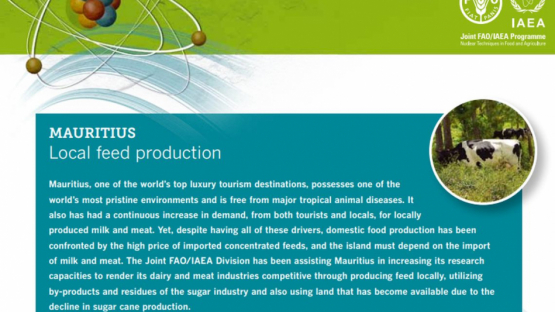
Mauritius: Local Feed Production
The Joint FAO/IAEA Centre has been assisting Mauritius in increasing its research and extension capacities to render its dairy and meat industries competitive through producing feed locally, utilising by-products and residues of the sugar industry and also using land that has become available due to the decline in sugar cane production.
- 1 of 3
- next ›

